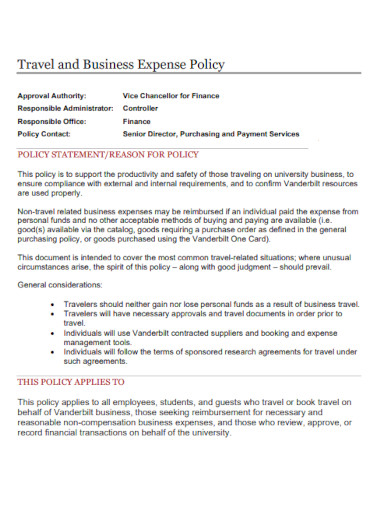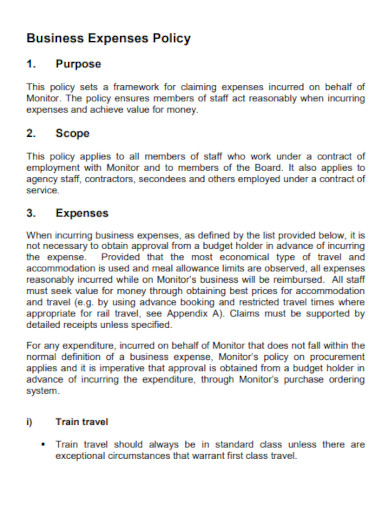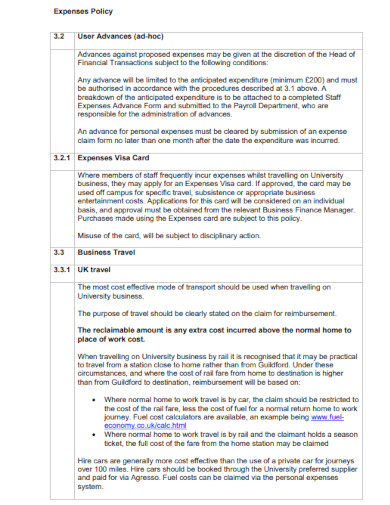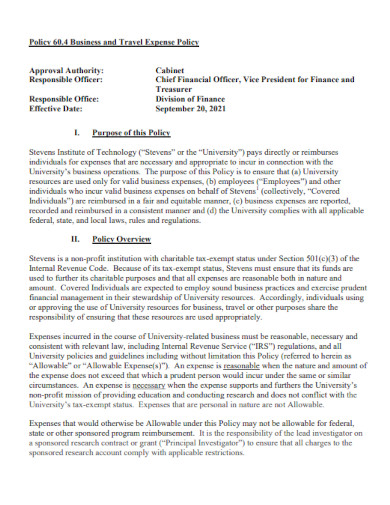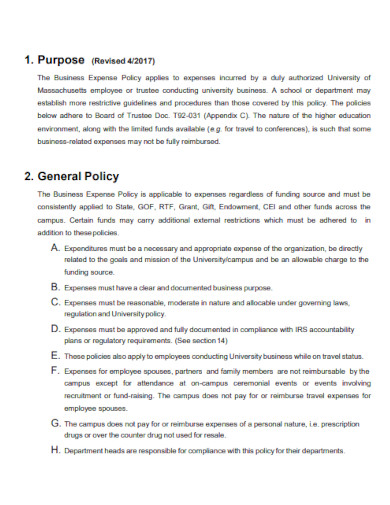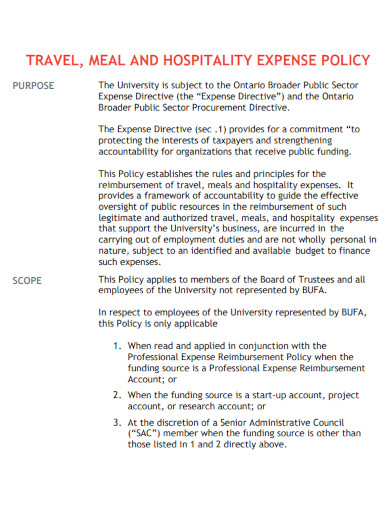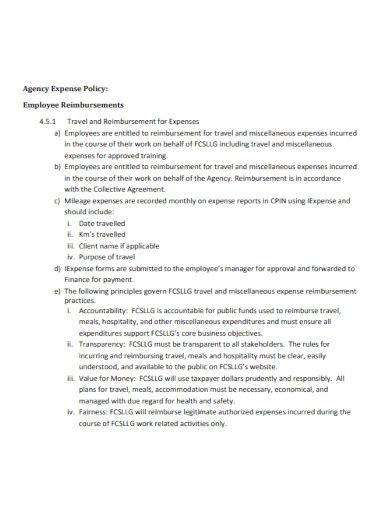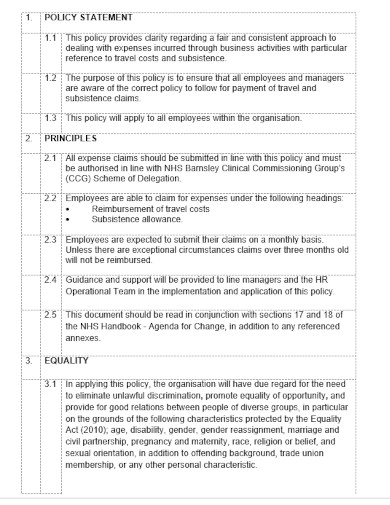Any company with employees who incur expenses must have a solid policy in place to govern these costs. Even the organization that has just a handful of employees racking up expenses needs a guide to explain what is or isn’t reimbursable. By developing an expense management policy, and then adjusting it as needed as your company grows, you’ll be able to keep costs manageable while also keeping your employees engaged and productive. Having proper guidelines in place is critical to maintaining control when it comes to employee travel and expenses (the second largest controllable cost after salaries1 ). So, the first logical step to finding a better way to do expenses is to create an expenses policy.
10+ Expense Policy Samples
1. Travel and Expense Policy Template

2. Sales Expenses Reimbursement Policy Template
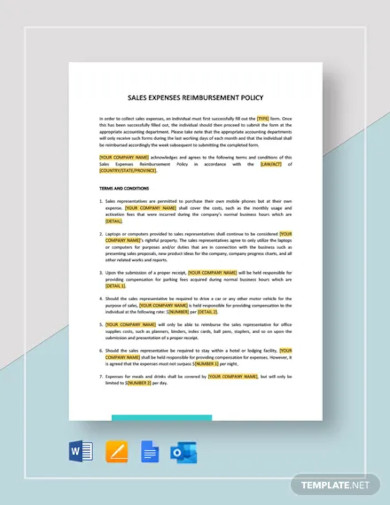
3. Restaurant Sales Expenses Reimbursement Policy Template
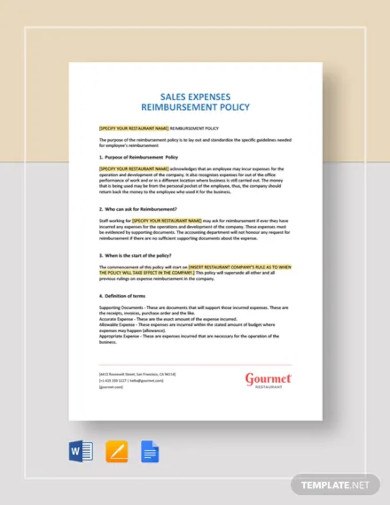
4. Travel and Business Expense Policy
5. Business Expense Policy
6. Staff Expense Policy
7. Standard Expense Policy
8. Expense Policy in PDF
9. Hospitality Expense Policy
10. Agency Expense Policy
11. Expense Policy in DOC
What Is an Expense Policy?
An expense policy is a formal set of guidelines that clearly outlines exactly what is and isn’t an approvable expense. It also helps the accounting department and/or approvers quickly decide whether an expense is reimbursable or not. This policy clearly outlines exactly when employees can expect to be reimbursed for their expenses (typically 30 days or less, depending on the company) and any recourse they have if an expense is rejected.
How to Make an Expense Policy?
Follow these steps when developing your expense policy:
1. Keep it Simple
A policy should be a helpful guideline to explain what employees can and can’t claim on expenses – to make it easy for everyone to read and understand. Keep the rules simple, and people will be more likely to remember them and follow them.
2. Make it Fair and Flexible for Everyone
Employees need to be able to claim reasonable business expenses. For example, business travellers shouldn’t have to spend hours searching for a hotel that’s under the limit or feel put-out because they can’t have a cup of tea or a sandwich while off site. The bottom line is: no-one should have to be out of pocket if they spend sensibly and a little flexibility goes a long way, because happy employees are more productive, which leads to long-term business success.
3. Highlight the Positive Aspects
The rules are the rules, but there’s usually a good reason for them. Make sure employees know why the rules exist, and it will be easier to enforce them.
4. Get Buy In
Get agreement about the policy with both managers and employees upfront. Having discussions with a wide range of stakeholders lets you identify grey areas and decide, together, whether proposed revisions are fair or not
5. Reinforce Rules Well
Let the policy be the bad guy; not the manager. Consider giving your managers extra training on the policy and how to apply it – or put a system in place that can reject claims on behalf of those approving claims (so the rejections don’t feel personal). You could also put a system in place that flags anything that’s out-of-policy before individuals can actually submit a claim – and give them a chance to comment if there’s a valid business reason.
6. Use Sensible Rules
don’t assume that one-size-fits-all. If you’ve got just one policy that applies to people in different regions, you might need to create local versions that take cultural variations, differing costs and legislation into account.
7. Pay Promptly
Remember, doing expenses can be stressful and even emotional, especially if people aren’t reimbursed quickly – and if employees have paid for them out of their own pocket. It’s best practice to give people an easy way to claim and then reimburse them promptly
8. Don’t Forget to Include the Vat
Businesses can reclaim VAT on most employee expenses – but only if there are properly documented receipts. Make sure your receipts are captured (more and more local tax offices will accept digital receipts – so a photographed copy is enough), and, if necessary, get external experts to help with VAT reclaim. There could be more money in it than you think.
FAQs
What should an expense policy include?
All expense management policies should include a complete list of which expenses the company will pay for. Make sure your list includes (but isn’t necessarily limited to):
- Hotel accommodations
- Transportation expenses
- Mileage reimbursement
- Food/drink costs
- Any rules concerning alcohol
- Entertainment expenses
- Business-related items (i.e., subscriptions, electronics, equipment, etc.)
- Any other miscellaneous expenses (i.e., postage, birthday cakes for employees, etc.)
- Special considerations when traveling outside of home country
- Variations in policy for different roles and management levels
- Specific budgets for each type of expense (e.g., travel, supplies, food, etc.)
- Explanations around preferred providers: Ensure employees understand the rules around when employees must use preferred hotels, airlines, rental car companies or other providers and when there is flexibility. Be clear about how and when exceptions are allowed.
- Any and all expenses that the company isn’t willing to pay for
- Specific instructions for claiming expenses
- Your policy on cash advances
- The reimbursement process
- Company-issued credit card rules
What are the benefits of an expense policy?
- One of the best ways to control employee spend is to implement an expense management policy that everyone in the organization will follow. That way, when an expense is rejected or questioned, your policy will serve as a standard for making final decisions on whether to reimburse the costs or not.
- Standardizes rules for a company’s expense management.
- Prevents employees from claiming they “weren’t told” that they wouldn’t be reimbursed for a specific expense.
- Helps employees familiarize themselves with the rules and know in advance whether the purchase that they’re making is going to be reimbursed.
- Gives approving managers a guidebook to work on (versus having to ask about every “questionable” expense).
- Helps prevent financial fraud and identify when an employee is abusing the system.
Create clear categories and budgets. Employees need to know how much is allowed, and which expense categories they can spend under. Be fair. Consistency is key. You shouldn’t plan to treat different employees differently, and your policy needs to be applied company-wide. Keep it simple. Almost nobody is passionate about expenses (except Spendesk!), and your team isn’t going to read a novel. You want them to be able to answer their own questions, so keep it short and sweet. Update often. This should be the same for most company processes. Make sure it’s somebody’s responsibility to see whether team members are using it, and how it can be improved. Check the regulations. Obviously, the most important thing is to keep compliant with the local laws. To help you get started making the expense policy, download our free sample templates above to use as your guide!
Related Posts
FREE 10+ Plagiarism/Cheating Policy Samples in MS Word | PDF
FREE 50+ Policy Approval Samples in PDF | MS Word
FREE 10+ Related Personnel Policy Samples in MS Word | PDF
FREE 10+ Suspension And Expulsion Policy Samples in MS Word | PDF
FREE 10+ Uniform Complaint Policy and Procedure Samples in PDF
FREE 10+ Bullying Policy Samples in MS Word | PDF
FREE 10+ Fiscal Control Policy Samples & Templates in MS Word | PDF
FREE 10+ Cooperative Policy Samples & Templates in MS Word | PDF
FREE 10+ Disenrollment Policy Samples in MS Word | PDF
FREE 10+ Donation Policy Samples & Templates in MS Word | PDF
FREE 10+ IT and Software Policy Samples in PDF | MS Word | Pages | Google Docs
FREE 50+ Policy Samples in PDF | MS Word
FREE 50+ Membership Policy Samples in PDF
FREE 10+ Shipping Policy Samples in PDF
FREE 10+ Website Policy Samples in PDF | MS Word | Pages | Google Docs | Outlook

